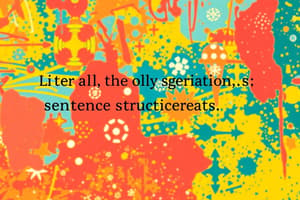Podcast
Questions and Answers
What is the purpose of using context clues when encountering unfamiliar words?
What is the purpose of using context clues when encountering unfamiliar words?
- To create long lists of vocabulary words
- To memorize definitions of words
- To determine the grammatical structure of sentences
- To infer meaning based on surrounding text (correct)
Which of the following strategies is primarily used to grasp the overall theme of a text?
Which of the following strategies is primarily used to grasp the overall theme of a text?
- Questioning the author's intent
- Skimming for general understanding (correct)
- Annotating to clarify complex ideas
- Scouting for specific details
When differentiating between the main idea and supporting details, what should be prioritized?
When differentiating between the main idea and supporting details, what should be prioritized?
- The emotional tone of the writing
- The author's choice of vocabulary
- The primary point conveyed in the text (correct)
- The length of the text
What technique is emphasized for vocabulary development through visual representations?
What technique is emphasized for vocabulary development through visual representations?
Which aspect of reading comprehension involves drawing conclusions based on the text's context?
Which aspect of reading comprehension involves drawing conclusions based on the text's context?
Which sentence is an example of a compound sentence?
Which sentence is an example of a compound sentence?
What is the primary role of imagery in literature?
What is the primary role of imagery in literature?
Which of the following best describes a dynamic character?
Which of the following best describes a dynamic character?
What is the purpose of a thesis statement in writing?
What is the purpose of a thesis statement in writing?
Which best defines symbolism in literature?
Which best defines symbolism in literature?
Identify a feature that enhances clarity in writing.
Identify a feature that enhances clarity in writing.
How does the rising action fit into the plot structure?
How does the rising action fit into the plot structure?
What does subject-verb agreement ensure in a sentence?
What does subject-verb agreement ensure in a sentence?
Flashcards are hidden until you start studying
Study Notes
Grammar
- Parts of Speech: Nouns, verbs, adjectives, adverbs, pronouns, prepositions, conjunctions, interjections.
- Sentence Structure:
- Simple: one independent clause.
- Compound: two independent clauses connected by a conjunction.
- Complex: one independent clause and at least one dependent clause.
- Compound-complex: multiple independent clauses and at least one dependent clause.
- Tenses: Present, past, future; perfect and continuous forms.
- Punctuation:
- Commas: lists, clauses, and direct address.
- Periods, exclamation marks, and question marks for sentence endings.
- Quotation marks for direct speech and titles of short works.
- Subject-Verb Agreement: Singular subjects take singular verbs, plural subjects take plural verbs.
Literature Analysis
- Literary Elements:
- Character: Protagonist, antagonist, development (static vs. dynamic).
- Setting: Time and place, influences story and characters.
- Plot: Structure (exposition, rising action, climax, falling action, resolution).
- Theme: Central ideas or messages of the work.
- Style: Author's unique voice; includes diction, tone, and syntax.
- Literary Devices:
- Imagery: Descriptive language appealing to the senses.
- Metaphor and Simile: Comparisons to enhance understanding.
- Symbolism: Objects or actions representing larger ideas.
- Irony: Contrast between expectations and reality.
- Critical Perspectives: Feminist, Marxist, Psychoanalytic, Post-colonial.
Writing Techniques
- Thesis Development: Clear, concise statement of the main argument or claim.
- Paragraph Structure: Topic sentence, supporting sentences, concluding sentence.
- Transitions: Words or phrases that guide readers through the text (e.g., however, furthermore).
- Drafting: Multiple drafts to refine ideas and structure.
- Revision and Editing: Focus on content, clarity, grammar, and punctuation.
Reading Comprehension
- Active Reading: Annotate texts, highlight key ideas, and ask questions.
- Main Idea vs. Supporting Details: Identify the primary point and evidence.
- Inference: Read between the lines; draw conclusions based on context.
- Summarization: Condense the text into key points and themes.
- Strategies: Skim for general understanding, scan for specific information.
Vocabulary Development
- Context Clues: Use surrounding text to infer meaning of unknown words.
- Word Parts: Understand roots, prefixes, and suffixes for better comprehension.
- Synonyms and Antonyms: Expand vocabulary by learning similar and opposite words.
- Word Mapping: Visual representations of word meanings and associations.
- Regular Practice: Engage with new words in writing and conversation.
Grammar
- Parts of Speech: Includes nouns, verbs, adjectives, adverbs, pronouns, prepositions, conjunctions, interjections.
- Sentence Structure:
- Simple sentences contain one independent clause.
- Compound sentences feature two independent clauses linked by a conjunction.
- Complex sentences have one independent clause and at least one dependent clause.
- Compound-complex sentences comprise multiple independent clauses with at least one dependent clause.
- Tenses: Encompasses present, past, future, including perfect and continuous forms.
- Punctuation:
- Commas are used for lists, clauses, and direct address.
- Periods, exclamation marks, and question marks signal sentence endings.
- Quotation marks denote direct speech and titles of short works.
- Subject-Verb Agreement: Singular subjects pair with singular verbs, while plural subjects match with plural verbs.
Literature Analysis
- Literary Elements:
- Character types include protagonists and antagonists, with focus on development (static vs. dynamic).
- Setting encompasses the time and place, influencing the story and characters.
- Plot structure consists of exposition, rising action, climax, falling action, and resolution.
- Themes represent central ideas or messages within the work.
- Style reflects the author's unique voice, incorporating diction, tone, and syntax.
- Literary Devices:
- Imagery utilizes descriptive language to appeal to the senses.
- Metaphors and similes create comparisons for enhanced understanding.
- Symbolism uses objects or actions to represent broader ideas.
- Irony displays a contrast between expectations and reality.
- Critical Perspectives: Refers to analytical approaches such as Feminist, Marxist, Psychoanalytic, and Post-colonial.
Writing Techniques
- Thesis Development: Essential for articulating clear and concise main arguments or claims.
- Paragraph Structure: Composed of a topic sentence, supporting sentences, and a concluding sentence.
- Transitions: Utilize words or phrases (e.g., however, furthermore) to guide readers through the text.
- Drafting: Involves creating multiple drafts to refine ideas and structure effectively.
- Revision and Editing: Focus areas include content clarity, grammar, and punctuation accuracy.
Reading Comprehension
- Active Reading: Engage with texts through annotation, highlighting key ideas, and posing questions.
- Main Idea vs. Supporting Details: Differentiate between the primary point and supplementary evidence.
- Inference: Develop skills to draw conclusions based on contextual clues.
- Summarization: Condense texts into essential points and recurring themes.
- Strategies: Employ skimming for overall understanding and scanning for specific details.
Vocabulary Development
- Context Clues: Use surrounding text to deduce meanings of unfamiliar words.
- Word Parts: Grasp roots, prefixes, and suffixes to enhance comprehension.
- Synonyms and Antonyms: Boost vocabulary by learning words with similar meanings and their opposites.
- Word Mapping: Visual tools to represent word meanings and connections.
- Regular Practice: Encourage the use of new vocabulary in writing and conversation for better retention.
Studying That Suits You
Use AI to generate personalized quizzes and flashcards to suit your learning preferences.




